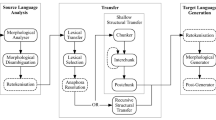Abstract
The chapter reports the results of a practical comparison of different parsing strategies. The research was carried out in the context of a larger project for the development of a machine translation (MT) system for translating avalanche forecast bulletins from German to French. The design of the MT system requires controlled input and no post-editing of the translated texts. The parsing experiment had as a goal to select the most suitable parsing strategy for a parser that allows the composition of the sentences in on-line fashion with mouse and windowing.1 In order to guarantee correct translation, the input system accepts only words and sentences that are known by their grammar and dictionary and it refuses wrong input. To minimize input errors, the user can select the possible next words with the mouse from different windows, which display the choices at a particular point in the sentence. The sentences are parsed word by word from left to right so that wrong input is detected immediately. After each word, the input device has to predict, with the help of the parser, all the words that can possibly continue the sentence that is being made. For our type of on-line parser, time is critical. The interface window has to be refreshed immediately after each word chosen by the user.
Access this chapter
Tax calculation will be finalised at checkout
Purchases are for personal use only
Preview
Unable to display preview. Download preview PDF.
Similar content being viewed by others
References
Aho, A. & and Ullman, J., 1979, Principles of compiler design, Addison Wesly.
Earley, J., 1970, “An efficient context-free parsing algorithm,” Communications of the ACM, 13(2), 94–102.
Kay, M., 1982, Algorithmic schemata and data structures in syntactic processing, CSL-80-12, Xerox Parc, Palo Alto.
Martin, W., Church, K., & R. Paul, 1981, Preliminary analysis of a breadth-first parsing algorithm: Theoretical and experimental results, MIT LCS Technical report.
Pratt, V., 1975, “LINGOL — A progress report,” Proc. 4th 1JCA1, Tbilisi, 422–428.
Slocum, J., 1981a, A practical comparison of parsing strategies for machine translation and other natural language processing purposes, PhD University of Texas, Austin.
Slocum, J., 1981b, “A practical comparison of parsing strategies,” Proc. 19th ACL, Standford.
Steel, S. & De Roeck, A., 1987, Bi-directional parsing, in Hallam & Mellish (eds.), Advances in AI, Proc. of the 1987 AISB Conference, J. Wiley, London.
Tennant, H. R., et al., 1983, “Menu-based natural language understanding,” Proc. 21st ACL, 151–158.
Thompson, H., 1981, “Chart parsing and rule schemata in GPSG,” Proc. 19th ACL, Stanford.
Tomita, M., 1985, An efficient context-free parsing algorithm for natural languages and its applications, PhD CMU, Pittsburg. Also as: Efficient parsing for natural language. A fast algorithm for practical purposes. Kluwer, Boston, 1986.
Tomita, M., 1987, “An efficient augmented-context-free parsing algorithm,” Computational Linguistics, 13 (1/2).
Tomita, M., 1988, “Graph-structured stack and natural language parsing,” Proc. 26th ACL, Buffalo.
Winograd, J., 1983, “Language as a cognitive process,” Syntax, Addison-Wesley.
Wirén, M., 1987, “A comparison of rule-invocation strategies in context-free chart parsing,” Proc. 3rd European chapter ACL, 226–233.
Editor information
Editors and Affiliations
Rights and permissions
Copyright information
© 1991 Springer Science+Business Media New York
About this chapter
Cite this chapter
Shann, P. (1991). Experiments with GLR and Chart Parsing. In: Tomita, M. (eds) Generalized LR Parsing. Springer, Boston, MA. https://doi.org/10.1007/978-1-4615-4034-2_2
Download citation
DOI: https://doi.org/10.1007/978-1-4615-4034-2_2
Publisher Name: Springer, Boston, MA
Print ISBN: 978-1-4613-6804-5
Online ISBN: 978-1-4615-4034-2
eBook Packages: Springer Book Archive




